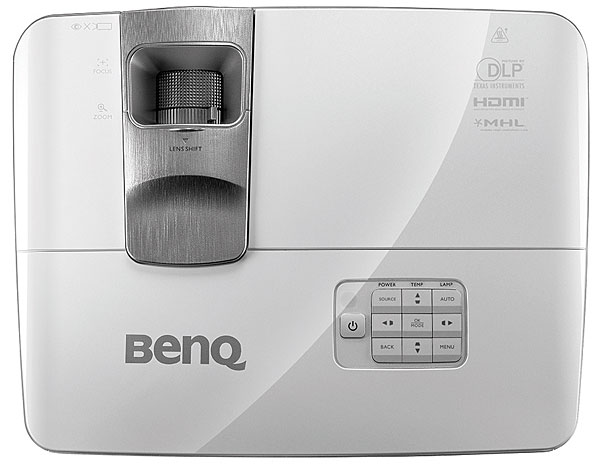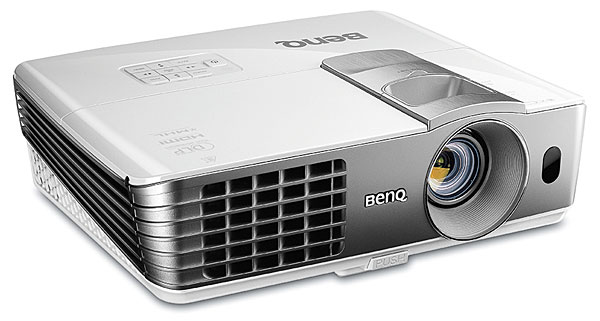The brightness and picture quality are good. I can watch it in our light room during the day with no problems. Also, i hasn't overheated since i bought it, and i'm saying this because a lot of people complain about it overheating. Free brazzers account
BenQ HT1075 DLP Projector Review Page 2
Not surprisingly though, given its price, its black level performance was far from amazing. Even at the lower settings of the Contrast control that I ultimately settled on (to reduce the output to a still bright 20 to 25 ft-L), the blacks changed very little by measurement and not at all by eye. Those gray blacks remained one of the projector’s prime flaws, likely unavoidable in such a budget design.
 In the past year or so, I’ve viewed a lot of projectors from JVC and Sony, not to mention plasma, locally dimmed LED LCD, and even OLED flat screens—all of which offered scrumptious blacks but cost considerably more than the BenQ. The BenQ couldn’t come close to that, but I did adjust to its grayish look on dark, low-contrast scenes. Scenes with dark backgrounds and bright highlights, however, fared much better, thanks to the projector’s high brightness.
In the past year or so, I’ve viewed a lot of projectors from JVC and Sony, not to mention plasma, locally dimmed LED LCD, and even OLED flat screens—all of which offered scrumptious blacks but cost considerably more than the BenQ. The BenQ couldn’t come close to that, but I did adjust to its grayish look on dark, low-contrast scenes. Scenes with dark backgrounds and bright highlights, however, fared much better, thanks to the projector’s high brightness.
The BenQ did fail our 2:2 HD and 2:2 SD upconversion tests, a relatively inconsequential test on which more than a few displays have also stumbled. But it passed all the others.
Other issues? Yes, I did occasionally see DLP rainbows, despite the projector’s fast, multi-segment color wheel. But I’m very sensitive to this artifact of single-chip DLP projectors that employ a color wheel; some viewers can’t see DLP rainbows at all. For the most part, I was able to ignore them. There’s also some light leakage from the side of the projector’s case, but that shouldn’t be an issue if the projector is mounted either below or above eye level. There was, also, a substantial amount of dither-like video noise in the picture, particularly on dark scenes. But this was essentially invisible at a typical viewing distance.
Beyond those reservations, there’s a lot to like here. The picture is bright, bold, and sharp (at the optimum 0 setting of the Sharpness control) without going over the top into edge enhancement. Even before calibration, it looked very good in the default Cinema Picture Mode, despite some so-so measured results. This is good news for the majority of buyers who are unlikely to spend $400 or so to calibrate a $1,200 display. Calibration gave me slightly more natural fleshtones and a more reassuringly accurate set of color measurements, but many viewers will be happy with the results out of the box. Just keep in mind that parts variations in any display, not to mention the projection lamps, can produce differences from one sample to another that only a full color calibration can level out.
Calibrated or not, the BenQ produced very satisfying pictures. Oblivion, a beautifully crisp transfer, was sharp from corner to corner (except for the dream scenes, which use a softer edge focus). The film’s few dark scenes (particularly in the ruins of the underground library) suffered little from the BenQ’s limited blacks because those scenes have bright highlights. The film’s deliberately muted color palette was also perfectly rendered. But the projector can produce brilliant color where needed. The computer-animated Frozen looked eye-poppingly glorious, particularly in the scenes where Anna is searching for Elsa in the ice- and snow-covered mountains. In both of these films, however, my 2.35:1 projection screen did eliminate any distractions from the BenQ’s gray (rather than deep black) letterbox bars, since those bars lie beyond the active screen area.

My 3D viewing of the BenQ was limited, but ghosting was minimal and the projector’s superior brightness was just what the doctor ordered for 3D. You won’t see 3D this bright in a theater, or in many home theater setups. If you’re still deep enough into 3D to take the plunge and buy 3D glasses to go with the HT1075 (optional at $59/pair) you might just be amazed by what you see.
But 3D viewing didn’t come without issues. As first tested, the DLP 3D glasses wouldn’t work unless connected directly to the projector with the USB charging cable—not exactly an optimum solution! In addition, the projector failed to pass 3D signals through two of the three new HDMI 2.0 AVRs I tried it with; neither a Marantz SR5009 nor a Denon AVR-X5400W would pass 3D to the projector, though a Pioneer SC-89 did. Both the Marantz and Denon triggered an onscreen notice suggesting the source (an Oppo BDP-103 BD player) was not compatible with 3D. Of course it is, so something was clearly awry in the HDMI communications (EDID) between these receivers and the projector.
BenQ subsequently sent us a new sample of the projector, together with revised glasses that worked perfectly with a direct connection from player to projector. (Be aware that a completely dark screen in 3D, as in a scene transition, appears onscreen as bright red when viewed without the glasses. This oddity disappeared with the glasses on.)

But the Marantz and Denon AVRs would still not pass 3D to the second BenQ short of activating the Oppo’s “Forced 3D” mode, which bypasses the EDID handshake. Few players have that option, however. To be fair, we have no way of knowing whether the communication issue was the fault of the projector or the AVRs. The Pioneer, Denon, and Marantz AVRs did, however, pass 3D to a JVC DLA-X35 projector, and a second Blu-ray player, a Toshiba model, suffered the same problem and was unable to pass 3D through the Denon and Marantz AVRs to the BenQ. Such is the mystery of HDMI that the introduction of any new version (2.0, in this case) brings with it a string of incompatibility bugs that only seem to work themselves out over time.
Conclusions
In the late 1990s, I had occasional movie nights for friends and members of the Stereophile and Stereophile Guide to Home Theater family. That was back in the CRT era, when the projector and processor under review approached six figures and the source was standard-
definition DVD or (ulp!) Laserdisc. One week when the CRT projector broke down, I had to use a new LCD projector that had just arrived for review. Those fledgling displays were pretty grim, and one attendee jokingly noted that I subjected the audience to a crummy LCD picture!
But make no mistake: Things have come a long way, and unless your movie-night party includes video guru Joe Kane’s evil twin, no one is likely to make any negative comment about the BenQ’s presentation. I certainly enjoyed all of the time I spent with it.
- Log in or register to post comments

























































